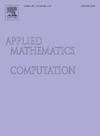An improved RBF-WENO scheme for hyperbolic conservation laws
IF 3.5
2区 数学
Q1 MATHEMATICS, APPLIED
引用次数: 0
Abstract
In this paper, a novel fifth-order weighted essentially non-oscillatory (WENO) scheme by using radial basis function (RBF) is proposed to solve hyperbolic conservation laws. The key idea is to choose multi-quadric (MQ) RBF and trigonometric function to construct numerical flux and smoothness indicator respectively. First, we modify the RBF interpolation making it into the WENO reconstruction framework along with representing it by a perturbation of polynomial. The explicit form of disturbance term on each stencil is given. Through selecting the appropriate shape parameters of MQ RBF, the relevant WENO scheme achieves sixth-order accuracy than other well-known fifth-order WENO schemes under some conditions. Moreover, some differential operators based on trigonometric function space are employed to obtain new smoothness indicators that efficiently evaluates the sharp change of gradient on the candidate stencil. To highlight the effectiveness of the proposed WENO scheme, this new scheme is applied to several one and two-dimensional hyperbolic test problems, and compared with the existing schemes such as WENO-JS, WENO-M and WENO-Z. The numerical results show higher accuracy can be achieved in the smooth regions of the solutions, and no non-physical oscillations occur near the discontinuities, which verifies the higher resolution property and the better discontinuity-capturing ability of the improved scheme.
双曲守恒律的改进RBF-WENO格式
本文提出了一种利用径向基函数求解双曲守恒律的五阶加权本质非振荡格式。关键思想是选择多重二次基RBF和三角函数分别构造数值通量和平滑度指标。首先,我们修改RBF插值,使其进入WENO重构框架,并通过多项式的扰动表示它。给出了各模板上扰动项的显式形式。通过选择合适的MQ RBF形状参数,在一定条件下,相关WENO方案比其他已知的五阶WENO方案具有六阶精度。此外,采用基于三角函数空间的微分算子,得到新的平滑度指标,有效地评价候选模板上梯度的急剧变化。为了突出WENO格式的有效性,将该格式应用于多个一二维双曲型测试问题,并与WENO- js、WENO- m和WENO- z等现有格式进行了比较。数值结果表明,在解的光滑区域可以获得较高的精度,并且在不连续点附近没有发生非物理振荡,验证了改进方案具有较高的分辨率和较好的不连续点捕获能力。
本文章由计算机程序翻译,如有差异,请以英文原文为准。
求助全文
约1分钟内获得全文
求助全文
来源期刊
CiteScore
7.90
自引率
10.00%
发文量
755
审稿时长
36 days
期刊介绍:
Applied Mathematics and Computation addresses work at the interface between applied mathematics, numerical computation, and applications of systems – oriented ideas to the physical, biological, social, and behavioral sciences, and emphasizes papers of a computational nature focusing on new algorithms, their analysis and numerical results.
In addition to presenting research papers, Applied Mathematics and Computation publishes review articles and single–topics issues.

 求助内容:
求助内容: 应助结果提醒方式:
应助结果提醒方式:


